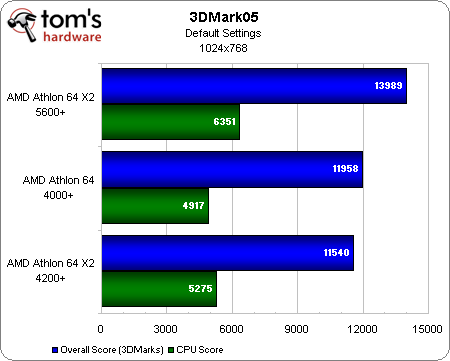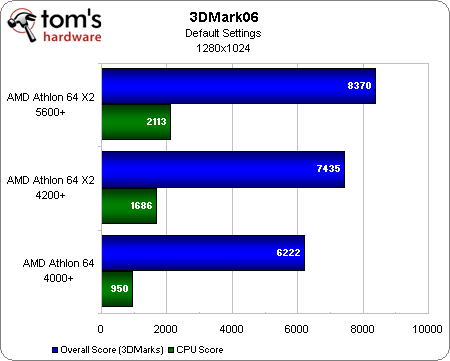Can Your Old Athlon 64 Still Game?
Synthetic Benchmarks
First, we take a brief look at Futuremark’s popular synthetic benchmarks, 3DMark05 and 3DMark06. We run both at their default settings.
3DMark05 was released in September 2004, before dual-core desktop processors were launched, and just weeks prior to the Athlon 64 4000+’s release. So this was a top-of-the-line gaming processor at the time.

3DMark05 does not support multi-threading in the overall performance tests and as a result we see the higher clock speeds and larger L2 cache of the A64 4000+ allowing it to beat out the X2 4200+. The high-clocked X2 5600+, on the other hand, leaves both behind by more than 2,000 points. Unlike in its holistic tests, 3DMark05 does have a multi-threaded CPU test, and we see the X2 4200+ surpass the higher-clocked A64 4000+ in the CPU score.
3DMark06 was released in January 2006, which was over six months after Intel and AMD had dual-core CPUs on the market. Multi-threading support was now implemented in not only the CPU tests, but in the overall tests as well.

Looking at 3DMark06, we see very different results, as this time the X2 4200+ more than makes up for its lower clock speeds and pulls far ahead of the single-core A64 4000+. As a matter of fact, it is able to pull halfway up to the X2 5600+. In the CPU tests we see the A64 4000+ far behind the dual cores and unable to reach a four digit score.
Now that we see a growing advantage for the dual-core CPUs in these Futuremark synthetic benchmarks, it is time to move onto some games to see if these indications of future performance equate to better performance in games.
Get Tom's Hardware's best news and in-depth reviews, straight to your inbox.
Current page: Synthetic Benchmarks
Prev Page Test System And Conditions Next Page Game Benchmarks: F.E.A.R.-
Schip FIRST POST!!! Nice Article though. I knew my brother would soon be doomed with his P4 2.8c ;)Reply -
"AMD Athlon 64 X2 4200 + dual-core, which has a 2.2 GHz Manchester architecture with 512 MB L2 cache per core."Reply
oau! that's a lot of cache :D -
neiroatopelcc I haven't read the actual article yet, but I bet the simple answer is no!Reply
I've got a backup gaming rig at home that barely cuts it. An x2 1.9ghz (oc'ed to 2.4) with an 8800gtx and 3gb memory. That rig struggles at 1280x1024 in some situations, and it can only be attributed to the cpu really. -
bf2gameplaya 2.8GHz Opteron 185 (up from 2.6GHz) with 2x1MB L2 cache is the ultimate s939 CPU....blows these weak benchmarks away.Reply
Who would have thought DDR would have such durability? There's something to be said for CAS2! -
neiroatopelcc But your opteron cpu still limits the modern graphics cards.Reply
Two years back I bought my 8800gtx, and realized it wouldn't come to its full potential in my opteron 170 (@ 2.7). A friend with another gtx paired with an e6400 chip (@ 3ghz) scored a full 30% higher in 3dmark than I, and it showed in games. Even in wow where you'd expect a casio calculator would deliver enough graphics power.
In short - ye ddr still work if you've got enthusiast parts, but that can't negate the effect a faster cpu would give. At least at decent resolutions (22" wide) -
dirtmountain This is a great article! It will give me something to show when i'm talking to people about a new system or just a GPU/PSU upgrade. Great job by Henningsen.Reply -
NoIncentive I'm still using a P4 3.0 @ 3.4 with 1 GB DDR 400 and an nVidia 6800GT...Reply
I'm building a new computer next week. -
randomizer I can echo the findings in Crysis. It didn't matter what settings I ran with a 3700 Sandy and an X1950 pro, the framerate was almost the same (albeit low 20s because the card is slower). Added an E6600 to the mix and my framerate tripled at lower settings.Reply
It would have been interesting to see how a 3000+ Clawhammer (C0 stepping) would do in Crysis. Single-channel memory, poor overclocking capabilities... FAIL! -
ravenware bf2gameplaya2.8GHz Opteron 185 (up from 2.6GHz) with 2x1MB L2 cache is the ultimate s939 CPU....blows these weak benchmarks away.Who would have thought DDR would have such durability? There's something to be said for CAS2!Reply
Thia ia true about the DDR. I recall an article on toms right after the release of the AM2 socket which tested identical dual core processors against their 939 counterparts; the tests showed little to no performance gains.
Great article, their has been some discussion about this in the forums as well.
I currently own a 939 4200+ x2 that's paired with a 7800GT; and this article shows what I thought to be accurate about the AMD64 chips. Their not as fast as some of the C2D's but they still kick ass.
Good job pointing out the single core factor in newer games too. As soon as the crysis demo was released I upgraded my San Diego core to a dual core and noticed the difference in crysis immediately.
This article gives me further confidence in my decision to hold on upgrading my system. I want to hold out for Windows7 D3D11 and more money to build an ape sh** machine :D
Nice article!!